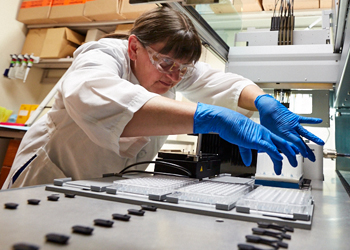Dr. Justin Grobe moved to the Medical College of Wisconsin’s Department of Physiology in June 2019. He holds a secondary appointment in the Department of Biomedical Engineering, and serves as the founding director of the Comprehensive Rodent Metabolic Phenotyping Core facility. Before joining the faculty at MCW, Dr. Grobe was a tenured associate professor in the Department of Pharmacology at the University of Iowa.
Learn more about Dr. Grobe
The Brain Renin-Angiotensin System in Metabolic Control and Obesity & Introduction to the MCW Comprehensive Rodent Metabolic Phenotyping Core (CRMPC)
Roughly 71% of adult Americans are overweight or obese, and although people can lose weight with diet, exercise, drugs, and surgeries, the majority regain that weight within a few years. Increasing evidence indicates that this weight regain is due to adaptation (suppression) of resting metabolic rate (RMR). This seminar will describe both ongoing research in our laboratory to understand RMR adaptation, and related rodent metabolic phenotyping capabilities provided by the new MCW Comprehensive Rodent Metabolic Phenotyping Core (CRMPC).
Part 1: Our research has identified a key role for the angiotensin II type 1 receptor (AT1), localized to a specific subtype of neuron within the hypothalamus that also expresses Agouti-related peptide (AgRP), in the normal, physiological, integrative control of RMR. Specifically, we have determined that in the lean state, AT1 in AgRP neurons couples through a Gi-mediated pathway to inhibit the cell and thereby ultimately disinhibit (stimulate) RMR. We have also discovered that obesity and RMR adaptation are associated with a disruption of this second-messenger signaling cascade, as AT1 receptors stop signaling through the Gi pathway and instead exhibit a “G protein switch” in which these receptors begin to signal via a Gq-mediated, stimulatory pathway. Finally, our work suggests that reactivation of the normal Gi signaling cascade within this neuron can restore RMR control even during obesity. We propose that this G protein switch within the AgRP neuron represents a molecular basis for the clinical manifestation of RMR adaptation during or following obesity.
Part 2: The new MCW CRMPC offers guided and fee-for-service access to advanced cardiometabolic phenotyping capabilities for rodents of various sizes (including mice and rats). Examples of major equipment offerings include a 16-chamber multiplexed home-cage phenotyping system (Promethion, Sable Systems International), a time-domain nuclear magnetic resonance body composition analyzer (LF110, Bruker), semi-micro bomb calorimeters (Parr), metabolic caging (Tecniplast), bioimpedance spectroscopy (ImpediVet), respirometry/indirect and direct calorimetry systems, an ashing oven, flame atomic absorption spectrophotometry, freezing point depression osmometry, and more (please see PMC8914175 for more details). The core additionally provides training, experimental design, best practice, data analysis, and statistical support.


